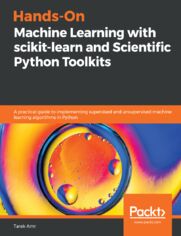Hands-On Machine Learning with scikit-learn and Scientific Python Toolkits - Helion

Tytuł oryginału: Hands-On Machine Learning with scikit-learn and Scientific Python Toolkits
ISBN: 9781838823580
stron: 368, Format: ebook
Data wydania: 2020-07-24
Ksi─Ögarnia: Helion
Cena ksi─ů┼╝ki: 39,90 z┼é (poprzednio: 117,35 z┼é)
Oszczędzasz: 66% (-77,45 zł)
Integrate scikit-learn with various tools such as NumPy, pandas, imbalanced-learn, and scikit-surprise and use it to solve real-world machine learning problems
Key Features
- Delve into machine learning with this comprehensive guide to scikit-learn and scientific Python
- Master the art of data-driven problem-solving with hands-on examples
- Foster your theoretical and practical knowledge of supervised and unsupervised machine learning algorithms
Book Description
Machine learning is applied everywhere, from business to research and academia, while scikit-learn is a versatile library that is popular among machine learning practitioners. This book serves as a practical guide for anyone looking to provide hands-on machine learning solutions with scikit-learn and Python toolkits.
The book begins with an explanation of machine learning concepts and fundamentals, and strikes a balance between theoretical concepts and their applications. Each chapter covers a different set of algorithms, and shows you how to use them to solve real-life problems. You'll also learn about various key supervised and unsupervised machine learning algorithms using practical examples. Whether it is an instance-based learning algorithm, Bayesian estimation, a deep neural network, a tree-based ensemble, or a recommendation system, you'll gain a thorough understanding of its theory and learn when to apply it. As you advance, you'll learn how to deal with unlabeled data and when to use different clustering and anomaly detection algorithms.
By the end of this machine learning book, you'll have learned how to take a data-driven approach to provide end-to-end machine learning solutions. You'll also have discovered how to formulate the problem at hand, prepare required data, and evaluate and deploy models in production.
What you will learn
- Understand when to use supervised, unsupervised, or reinforcement learning algorithms
- Find out how to collect and prepare your data for machine learning tasks
- Tackle imbalanced data and optimize your algorithm for a bias or variance tradeoff
- Apply supervised and unsupervised algorithms to overcome various machine learning challenges
- Employ best practices for tuning your algorithm's hyper parameters
- Discover how to use neural networks for classification and regression
- Build, evaluate, and deploy your machine learning solutions to production
Who this book is for
This book is for data scientists, machine learning practitioners, and anyone who wants to learn how machine learning algorithms work and to build different machine learning models using the Python ecosystem. The book will help you take your knowledge of machine learning to the next level by grasping its ins and outs and tailoring it to your needs. Working knowledge of Python and a basic understanding of underlying mathematical and statistical concepts is required.
Osoby które kupowały "Hands-On Machine Learning with scikit-learn and Scientific Python Toolkits", wybierały także:
- Think Stats. 3rd Edition 249,17 zł, (29,90 zł -88%)
- Python for Finance. Mastering Data-Driven Finance. 2nd Edition 249,17 zł, (29,90 zł -88%)
- Blueprints for Text Analytics Using Python 230,00 zł, (29,90 zł -87%)
- Practical Statistics for Data Scientists. 50+ Essential Concepts Using R and Python. 2nd Edition 230,00 zł, (29,90 zł -87%)
- Learn Python Programming 285,00 zł, (39,90 zł -86%)
Spis tre┼Ťci
Hands-On Machine Learning with scikit-learn and Scientific Python Toolkits. A practical guide to implementing supervised and unsupervised machine learning algorithms in Python eBook -- spis tre┼Ťci
- 1. Introduction to Machine Learning & Scikit-Learn
- 2. Making Decisions with Trees
- 3. Making decisions with linear equations
- 4. Preparing Your Data
- 5. Image processing with nearest neighbors
- 6. Text Classification - Not all data exists in tables
- 7. Neural Networks - Here comes the Deep Learning
- 8. Ensembles - When one model is not enough
- 9. The Y is as important as the X
- 10. Imbalanced Learn - Not even 1% win the lottery
- 11. Clustering - Grouping data when no correct answers are provided
- 12. Anomaly Detection - Finding Outliers in Data
- 13. Recommender System - Learning about users’ taste from their previous interactions





